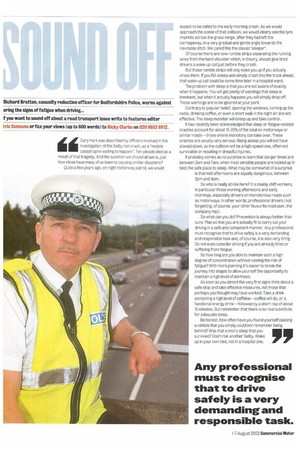ii Gary Hart was described by officers involved in the
Page 44

If you've noticed an error in this article please click here to report it so we can fix it.
Investigation of the Selby rail-crash, as a "mobile catastrophe waiting to happen". Ten people died as a result of that tragedy. And the question we should all ask is, just how close have many of us been to causing similar disasters?
Quite a few years ago, on night motorway patrol, we would expect to be called to the early morning crash. As we would approach the scene of that collision, we would clearly see the tyre imprints across the grass verge, after they had left the carriageway, in a very gradual and gentle angle towards the inevitable ditch. We called this the classic 'sleeper'.
Of course there are now rumble strips separating the running lanes from the hard shoulder which, in theory, should give tired drivers a wake-up call just before they crash.
But those rumble strips will only wake you up if you actually cross them. If you fall asleep and simply crash into the truck ahead, that wake-up call could be some time later in a hospital ward.
The problem with sleep is that you are not aware of exactly when it happens. YOU will get plenty of warnings that sleep is imminent, but when it actually happens you will simply drop off. Those warnings are to be ignored at your peril.
Contrary to popular belief, opening the windows, turning up the radio, drinking coffee, or even a short walk in the night air are not effective. The sleep monster will creep up and take control.
It has recently been acknowledged that sleep or fatigue-related crashes account for about 15-20% of the total on motorways or similar roads—those where monotony can take over. These crashes are usually very serious. Being asleep you will not have slowed down, so the collision will be a high-speed one, often not survivable or resulting in dreadful injures.
It probably comes as no surprise to learn that danger times are between 2am and Tam, when most sensible people are tucked up in bed; the safe place to sleep. What may be somewhat of a surprise is that mid-afternoons are equally dangerous, between 2pm and 4pm.
So who is really at risk here? It is mainly shift workers, in particular those working afternoons and early mornings, especially drivers on monotonous roads such as motorways. In other words, professional drivers (not forgetting, of course, your other favourite road user, the company rep).
So what can you do? Prevention is always better than cure. Plan so that you are actually a to carry out your driving in a safe and competent manner. Any professional must recognise that to drive safely is a very demanding and responsible task and, of course, it is also very tiring. Do not even consider driving if you are already tired or suffering from fatigue.
So how long are you able to maintain such a high degree of concentration without running the risk of fatigue? With more planning it's easier to break the journey into stages to allow yourself the opportunity to maintain a high level of alertness.
As soon as you detect the very first signs think about a safe stop and take effective measures, not those that perhaps you thought may have worked. Take a drink containing a high level of caffeine—coffee will do, or a Functional energy drink—followed by a short nap of about 15 minutes. But remember that there is no real substitute for adequate sleep.
Be honest, how often have you found yourself passing a vehicle that you simply could not remember being behind? Was that a micro sleep that you survived? Don't risk another Selby. Wake up in your own bed, not in a hospital one.




























































































































































